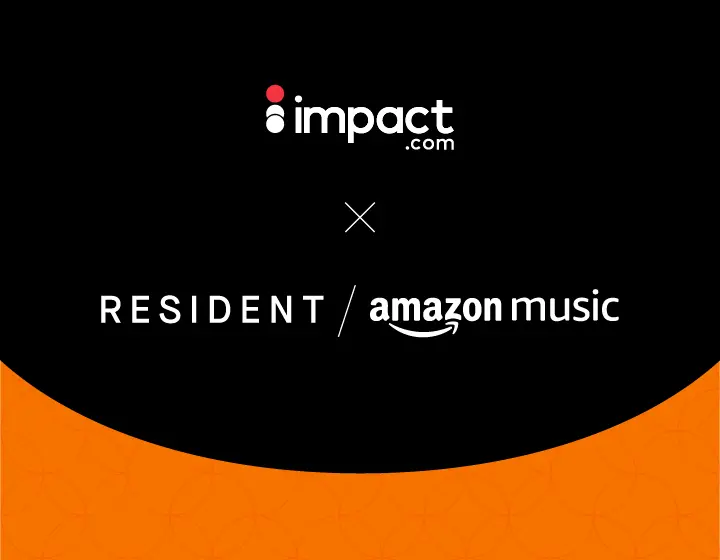A reported 77 percent of consumers are most likely to purchase a product from a personal recommendation. And influencers are heavy hitters in this arena. Data reported by impact.com shows that 63 percent of consumers repeatedly purchase based on an influencer’s recommendation or review at least some of the time.
So it’s no wonder experts expect the influencer marketing industry to be worth a whopping $24 billion this year.
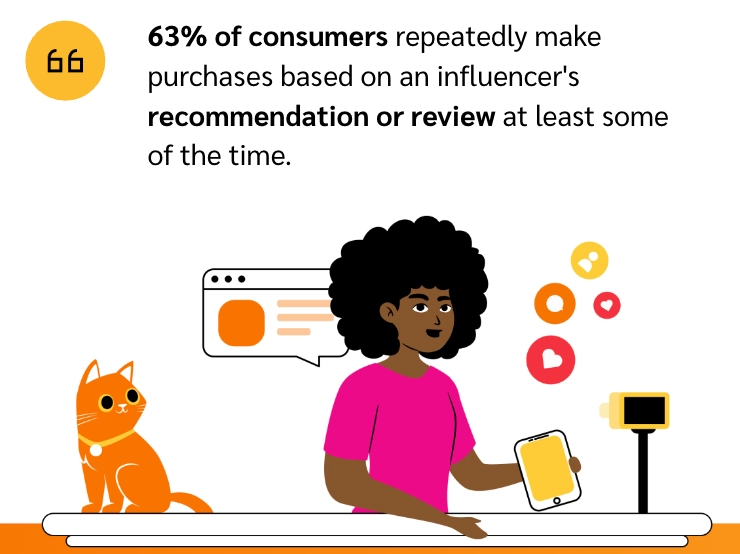
As influencers continue to rise, the marketing industry has recently made significant progress holistically merging influencer and affiliate strategies. This offers complete visibility into tracking and measurement for marketers to grasp the buyer’s journey from awareness down to purchase.
Whitney Neisz from Amazon Music explains how social media has disrupted traditional affiliate and influencer strategies here:
Let’s explore opportunities, challenges, and tactical steps you can take to integrate your influencer and affiliate programs.
Key similarities and differences between influencers and affiliates
Influencers and affiliates represent two pivotal yet distinct strategies for brand promotion and audience engagement. While both use the power of third-party endorsements to drive brand awareness and sales conversions, they differ significantly in their approach and execution. Let’s break it down.
Creators: Also known as influencers, these content pros authentically drive brand awareness and engagement. Influencers primarily use their substantial social media presence and content creation skills to shape consumer perceptions and promote brands through authentic storytelling and personal recommendations. Influencers range from nano- (less than 15k followers) to powerhouse mega-influencers (1m+ followers, often celebrities). Creators are experts in driving top-of-funnel results.

Brands can have their pick of influencers across many tiers. Read The ultimate guide to influencer tiers: from nano creators to megastars to learn more.
When brands should work with creators: To break into new markets, create a community, build product awareness and trust, and drive engagement, but not necessarily sales.
Affiliates: Affiliates are conversion experts that turn potential customers into purchasers. They promote products or services by linking to the merchant’s site, focusing on driving sales through targeted links and earning commissions based on generated leads or sales. These partners are experts in driving bottom-of-funnel results.
When brands should work with affiliates: When looking to drive sales in a performance-based and highly cost-effective manner but focus less on driving community, engagement, and brand awareness.
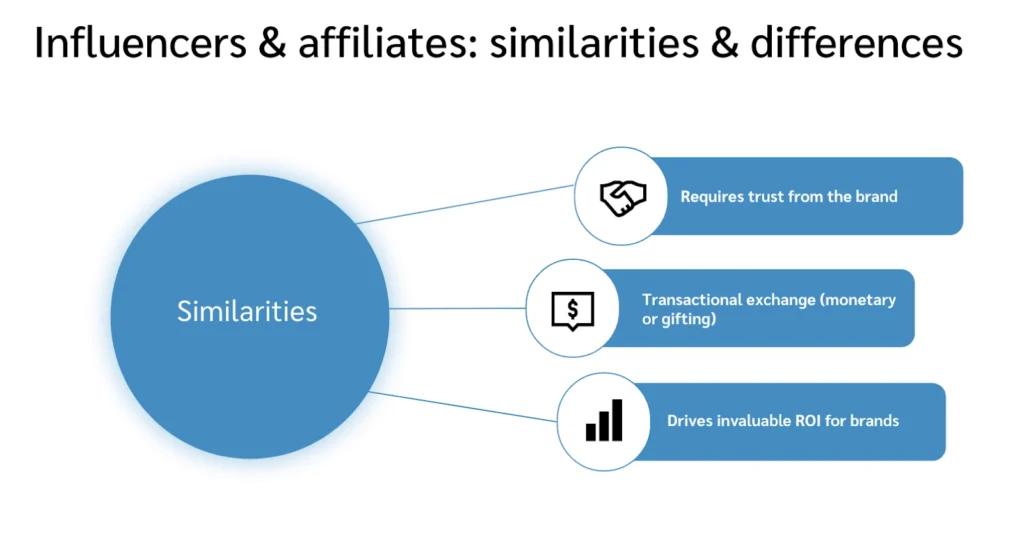
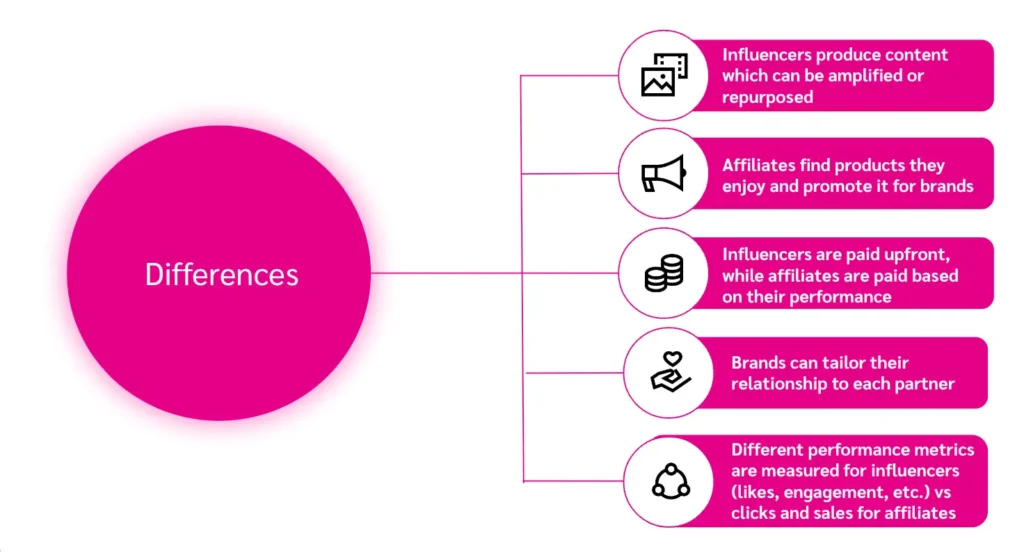
Their similarity lies in the underlying principle of trust and credibility. Both strategies rely on the trust influencers and affiliates have built with their audiences to effectively market products or services. Understanding these nuances is crucial for brands aiming to harness these strategies’ unique strengths and reach their target audiences more effectively.
Integrate your programs for predictable, sustainable growth
Consumers gain awareness through social media influencers, move to consideration via continually consuming product content, and often purchase using a promotional code.
This illustrates the power of influencers and affiliates when you position them throughout your marketing funnel. Influencers build trust and community. In contrast, affiliates drive trackable sales, guiding consumers through a buying journey that’s fully visible to marketers.
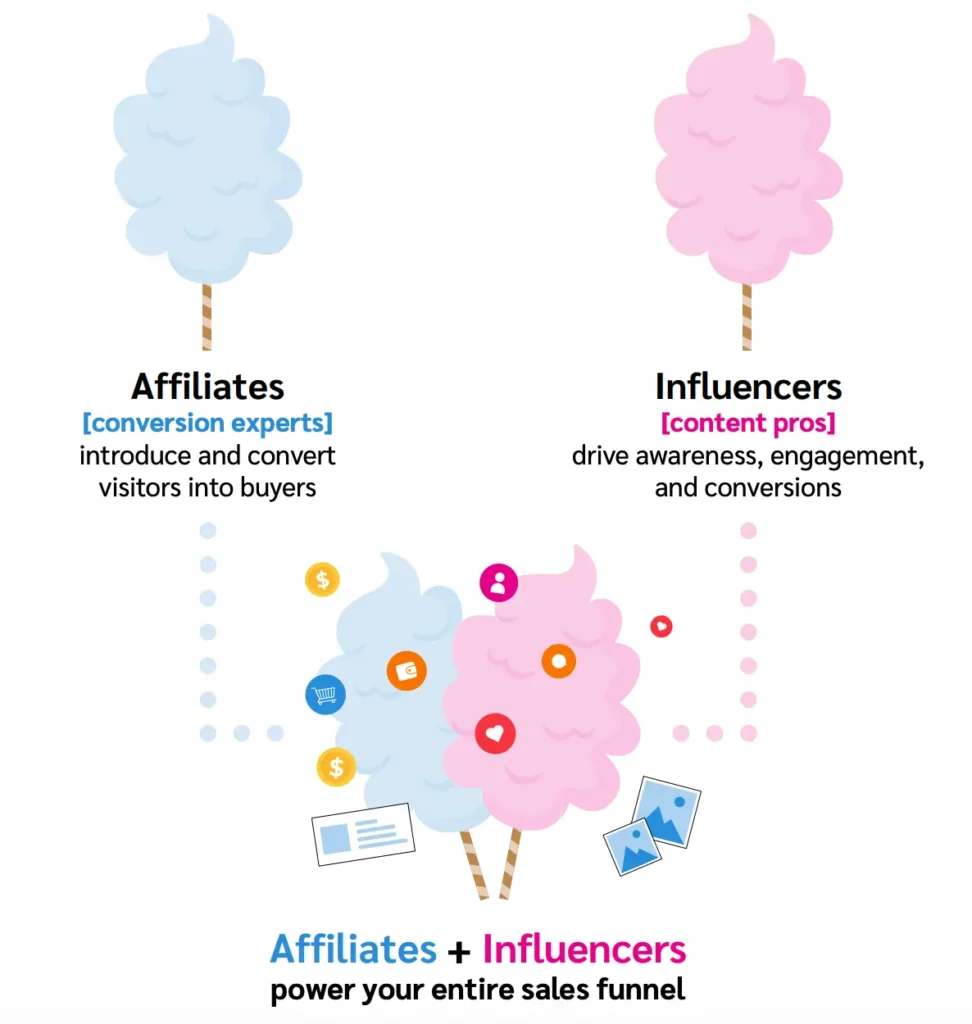
This further breaks down what this journey can look like. See the full visual here.
Additionally, these partners’ role in the customer life cycle is a distinguishing factor of how these programs align. Creator-led marketing goes beyond mere ‘brand loyalty,’ advancing to where dedicated fans become advocates, spreading the word and inspiring others to make purchases (often via an affiliate link).
There’s no full-funnel impact without measurement
Top-funnel metrics are relatively easy to attain via social media. However, connecting them with bottom-funnel metrics to tell a full-funnel story isn’t so simple. With affiliate tracking capabilities, you can have your finger on the pulse of the full customer journey, from awareness and engagement down to sales and return on investment (ROI).
In measuring the full funnel, marketers must understand that this journey often involves multiple touchpoints over time, resembling more of a zig-zag than a linear path. Despite advancements in attribution models, you shouldn’t lose sight of the long-term revenue that may not be directly attributable. For instance, a consumer could first become aware of a product through an influencer but purchase directly on the website six months later through an email offer from the brand. As such, you should evaluate immediate program success via top-of-funnel metrics, expecting sales to take quite a while. It’s important to set these expectations with management and ensure proper tracking is in place for measuring long-term results.
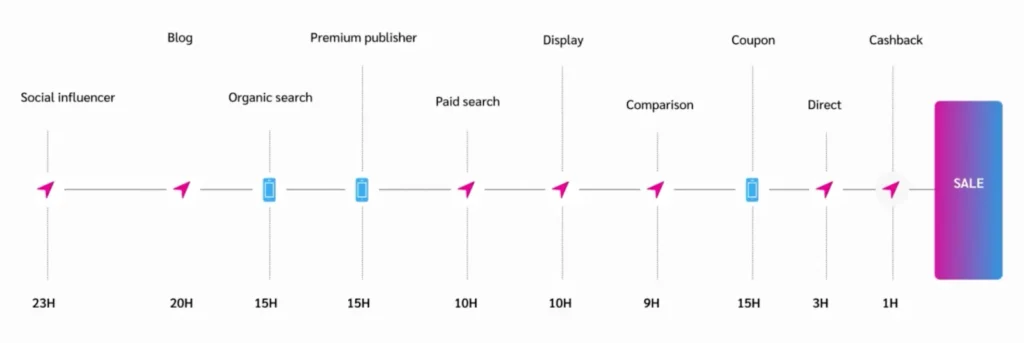
impact.com / creator helps you track each touchpoint before purchase, so you can reward the right partners.
Whitney Neisz from Amazon Music discusses the long-term ROI benefits of using influencers and affiliates in your program here:
Leveraging influencers and affiliates for community, content marketing and ecommerce
Working with influencers and affiliates is critical for brands looking to amplify their community, content marketing, and ecommerce efforts. When executed effectively, these partnerships offer a dual advantage—capitalizing on the influencers’ ability to authentically engage and expand community connections and harnessing the precision of affiliate marketing to drive measurable ecommerce results.
Nurturing a community of advocates as an extension of your brand
Building a community of brand advocates requires ongoing effort and collaboration like any relationship. When developing an online community, having a distinct brand and voice matters.
Most importantly, your influencer and affiliate partners need to love your product. This inspires authentic product recommendations—a key purchasing driver for consumers. Reach out to creators and gift them your products for a firsthand experience.
On the flip side, your partners have a trusted community they’ve built over time. And once you’ve secured official deals, they’ll do the work for you—securing reach, engagement, and sales.
Powering your content strategy with user-generated content (UGC)
Your affiliate and influencer partners play a tremendous role in your content strategy by leading in content creation and promotion. For creators, they offer unparalleled value in producing UGC, featuring product reviews and experiences, which tend to garner impressive engagement. To generate the highest ROI, the content should be amplified and repurposed via paid and organic channels.
Depending on the partnership terms, content can (and should) be reused in various ways, including:
- Publishing on the influencer and brands’ social channels
- Amplifying via paid channels, such as TikTok spark ads
- Embedding within commerce content
- Being used by an affiliate or alongside an affiliate link
Brand tip: UGC is often created organically, so use social listening tools and hashtag campaigns to track who’s already a brand advocate and uncover partnership opportunities.

Here’s an example of UGC from the influencer Kine Holm commissioned by the ecommerce brand Ellos. Read the Ellos case study [here].
Partnerships are necessary drivers for ecommerce
Influencers and affiliates have become crucial drivers in ecommerce through creator commerce. Also known as social commerce, this is a fully attributable practice in which creators and affiliates are leveraged across social channels to drive sales.
Creator-led commerce lives within the bottom of the funnel during the purchase. Let’s explore just how influential creator commerce truly is:
- According to research from Ad Age and The Harris Poll, 24 percent of respondents have bought an item through a creator’s curated lists of products on platforms like Amazon.
- According to research by TikTok, 78 percent of TikTok users purchased a product after seeing it featured in creator content on the platform.
- According to a report by Hubspot and Brandwatch, 80 percent of consumers buy products directly through social apps vs brand websites or third-party sellers.
Social media platforms like TikTok, YouTube, and Instagram continually develop new resources to enable brands and creators to create bottom-funnel content and track sales. And with integrations into platforms like impact.com / creator, marketers can easily run these campaigns within one platform.
Getting buy-in and building the right tech stack
Now that you’ve made it this far, let’s talk about getting buy-in from your team and finding the right tools to get started.
Team operations and management buy-in
According to Whitney Niesz, Sr. Global Affiliate & Partnership Lead from Amazon Music, starting small before scaling your integrated program is important. She recommends doing so in terms of budget and testing, then doubling down on strategies that garner strong performance. Once you’ve collected that data, you can make a case for scaling to key stakeholders.
Similarly, when taking steps to begin working collaboratively with various teams, it’s important to be patient and educate them on the value of integrating your influencer and affiliate programs. Whitney recommends leaning heavily on your internal advocates who have showcased their support for the strategy.
Here are three more essential buy-in considerations from Whitney:
- Partner with other teams with more budget, like Paid Social or Partnerships.
- Having a one-stop shop where creators can learn about your brand or ambassador program to build out your community further.
- If you have a low budget, use affiliate links and pay creators on a cost-per-action (CPA) basis, so you’re truly paying for performance.
Tools and resources for program success
Effective influencer and affiliate marketing demand more than manual effort, especially as operations expand and complexities increase. Whether managing programs internally or through an agency, the foundation lies in your tech stack.
Leverage software and managed services to help you:
- Automate your campaign, from discovery to recruitment, onboarding, cross-platform performance, all the way down to payment
- Uncover and recruit the best-fit creators for your brand, to kick off partnerships that result in lasting relationships
- Put a system in place to conduct ongoing communication with your creator partners
- Offer diverse and hybrid payment options for your various partners to meet their unique needs, influencing gifting, CPA, commissions, and any combination of the above
- Start small to test, track, and measure your program, prove program success, and ultimately begin scaling
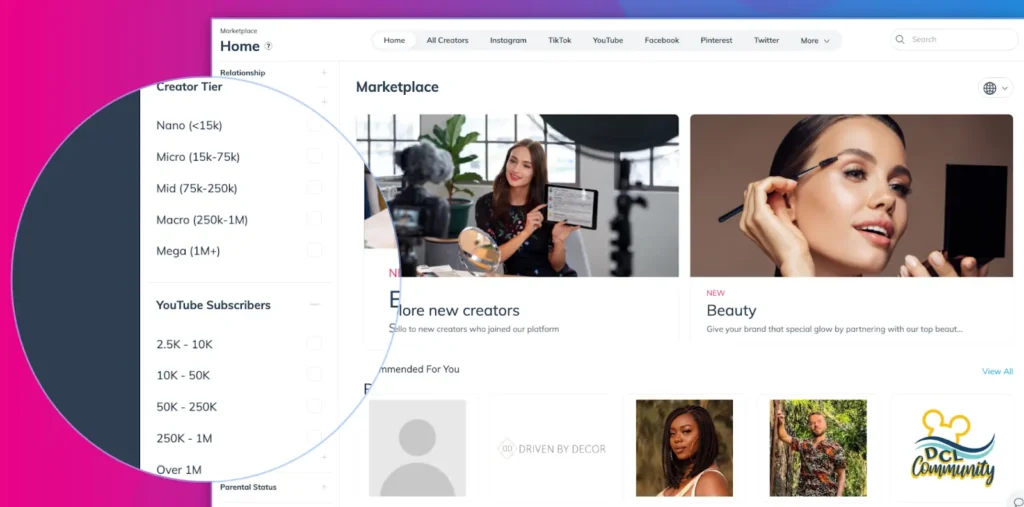
impact.com / creatorlets you filter for creators across various tiers, platforms, and more.
FAQs
Influencer marketing focuses on leveraging individuals with a significant social media presence to drive brand awareness, engagement, and trust through authentic storytelling and personal recommendations. In contrast, affiliate marketing concentrates on driving sales and conversions through partners who promote products or services using unique links or promo codes, earning commissions based on generated leads or sales. While influencers primarily enhance top-of-the-funnel activities, affiliates excel in bottom-of-the-funnel results.
Combining influencer and affiliate marketing strategies allows businesses to effectively target the full marketing funnel, enhancing brand visibility and engagement at the top and driving conversions at the bottom. This integrated approach provides complete visibility into the buyer’s journey, from initial awareness to purchase, enabling precise tracking and measuring campaign effectiveness. Furthermore, it leverages the strength of trusted endorsements across both spectrums, maximizing reach and impact on potential customers.
Start by setting clear objectives for what you hope to achieve through integration, such as increased brand awareness, higher engagement rates, or more conversions. Next, select the right software that offers comprehensive tracking and analytics capabilities to monitor performance across influencers and affiliates. Educate your team about the value of this integrated approach and begin with small tests to refine your strategy. Finally, continuously nurture your relationships with both influencers and affiliates, commissioning user-generated content (UGC) to engage and expand your community of potential buyers authentically
Opportunities for cross-team collaboration
Many marketers have started to combine their affiliate and influencer programs into one holistic strategy to generate and track full-funnel ROI. This opens endless opportunities for cross-team collaboration (and wins), understanding the full story of your partnerships, and ultimately driving increased reach, community, engagement, and conversions. Motivate the value of merging these partnerships with your team, then test and learn as you go. This strategy won’t be cutting-edge for long — it’s already becoming the norm.
Ready to grow your influencer and affiliate program? Request a demo today.


